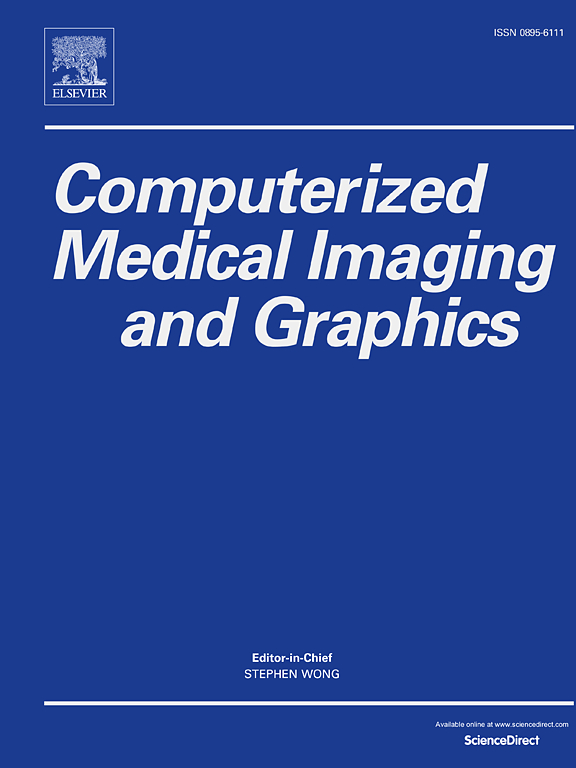Machine learning-based diagnostics of capsular invasion in thyroid nodules with wide-field second harmonic generation microscopy
IF 5.4
2区 医学
Q1 ENGINEERING, BIOMEDICAL
Computerized Medical Imaging and Graphics
Pub Date : 2024-10-01
DOI:10.1016/j.compmedimag.2024.102440
引用次数: 0
Abstract
Papillary thyroid carcinoma (PTC) is one of the most common, well-differentiated carcinomas of the thyroid gland. PTC nodules are often surrounded by a collagen capsule that prevents the spread of cancer cells. However, as the malignant tumor progresses, the integrity of this protective barrier is compromised, and cancer cells invade the surroundings. The detection of capsular invasion is, therefore, crucial for the diagnosis and the choice of treatment and the development of new approaches aimed at the increase of diagnostic performance are of great importance. In the present study, we exploited the wide-field second harmonic generation (SHG) microscopy in combination with texture analysis and unsupervised machine learning (ML) to explore the possibility of quantitative characterization of collagen structure in the capsule and designation of different capsule areas as either intact, disrupted by invasion, or apt to invasion. Two-step k-means clustering showed that the collagen capsules in all analyzed tissue sections were highly heterogeneous and exhibited distinct segments described by characteristic ML parameter sets. The latter allowed a structural interpretation of the collagen fibers at the sites of overt invasion as fragmented and curled fibers with rarely formed distributed networks. Clustering analysis also distinguished areas in the PTC capsule that were not categorized as invasion sites by the initial histopathological analysis but could be recognized as prospective micro-invasions after additional inspection. The characteristic features of suspicious and invasive sites identified by the proposed unsupervised ML approach can become a reliable complement to existing methods for diagnosing encapsulated PTC, increase the reliability of diagnosis, simplify decision making, and prevent human-related diagnostic errors. In addition, the proposed automated ML-based selection of collagen capsule images and exclusion of non-informative regions can greatly accelerate and simplify the development of reliable methods for fully automated ML diagnosis that can be integrated into clinical practice.
基于机器学习的宽视场二次谐波发生显微镜甲状腺结节囊性侵袭诊断。
甲状腺乳头状癌(PTC)是甲状腺中最常见的一种分化良好的癌症。PTC结节周围通常有一层胶原蛋白囊,可以防止癌细胞扩散。然而,随着恶性肿瘤的发展,这一保护屏障的完整性受到破坏,癌细胞就会侵入周围环境。因此,囊肿侵犯的检测对于诊断和选择治疗方法至关重要,而开发新方法以提高诊断性能则具有重要意义。在本研究中,我们利用宽视场二次谐波发生(SHG)显微镜,结合纹理分析和无监督机器学习(ML),探索了胶囊中胶原结构的定量表征以及将不同胶囊区域指定为完整、受侵袭破坏或易受侵袭区域的可能性。两步 K-均值聚类显示,所有分析组织切片中的胶原囊高度异质,并呈现出由特征性 ML 参数集描述的不同区段。后者允许对明显入侵部位的胶原纤维进行结构性解释,将其视为碎裂和卷曲的纤维,很少形成分布式网络。聚类分析还能区分 PTC 胶囊中初步组织病理学分析未将其归类为侵袭部位,但经进一步检查后可确认为前瞻性微侵袭的区域。所提出的无监督 ML 方法所识别的可疑部位和浸润部位的特征可以成为现有诊断包裹型 PTC 方法的可靠补充,提高诊断的可靠性,简化决策,并防止人为诊断错误。此外,所提出的基于 ML 的胶原囊图像自动选择和排除非信息区域的方法可以大大加快和简化可靠的全自动 ML 诊断方法的开发,并将其融入临床实践中。
本文章由计算机程序翻译,如有差异,请以英文原文为准。
求助全文
约1分钟内获得全文
求助全文
来源期刊
CiteScore
10.70
自引率
3.50%
发文量
71
审稿时长
26 days
期刊介绍:
The purpose of the journal Computerized Medical Imaging and Graphics is to act as a source for the exchange of research results concerning algorithmic advances, development, and application of digital imaging in disease detection, diagnosis, intervention, prevention, precision medicine, and population health. Included in the journal will be articles on novel computerized imaging or visualization techniques, including artificial intelligence and machine learning, augmented reality for surgical planning and guidance, big biomedical data visualization, computer-aided diagnosis, computerized-robotic surgery, image-guided therapy, imaging scanning and reconstruction, mobile and tele-imaging, radiomics, and imaging integration and modeling with other information relevant to digital health. The types of biomedical imaging include: magnetic resonance, computed tomography, ultrasound, nuclear medicine, X-ray, microwave, optical and multi-photon microscopy, video and sensory imaging, and the convergence of biomedical images with other non-imaging datasets.

 求助内容:
求助内容: 应助结果提醒方式:
应助结果提醒方式:


